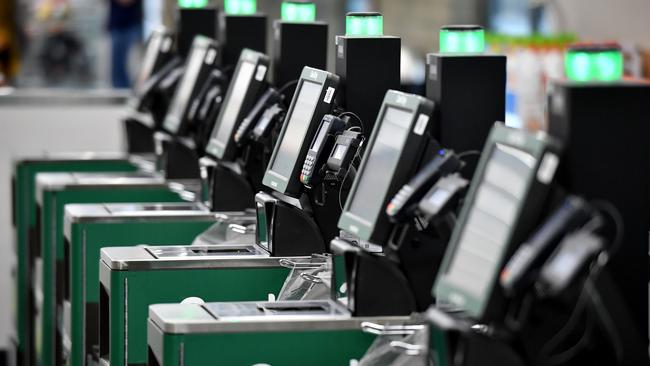Most shoppers are comfortable with self-checkouts, study finds
Love them or hate them, self-serve checkouts are here to stay. And there’s a trick to getting through them faster, supermarkets say.

VIC News
Don't miss out on the headlines from VIC News. Followed categories will be added to My News.
Barcodes added to stickers on loose fruit and vegetables are taking some pain out of self-serve shopping.
Customers can scan and automatically identify produce before it is weighed, rather than trawling through the checkout touchscreen to find the right variety.
The measure comes as a global study has found the majority of shoppers – 86 per cent – are comfortable with self-checkout technology.
Half said they actually preferred DIY checkout when in a store.
Identification labels have been gradually added to some apples, stone fruit, pears, mangoes, citrus and avocados sold at Woolworths.

Woolies’ merchandise manager for fruit, Warwick Hope, said: “Over the last few years, we have been progressively adding barcodes to loose fruit to make scanning through self-serve checkouts that little bit faster.
“We will continue to work with suppliers on a case-by-case basis to roll this out across more fresh fruit lines in the future.”
Coles said customers would start to see stickers with barcodes on most fruit and vegetables sold loose as more suppliers introduced them.
Coles fresh produce business category manager Daniel Corrigan said: “These barcodes improve traceability as they enable us to track which farm the produce comes from, and make it faster at the checkout as customers don’t have to look up individual produce”.
Zebra Technologies’ study, which included Australians, found three in five shoppers agreed self-checkout improved the customer experience.
That was especially the case for Millennials.
It surveyed 4811 customers and 1535 retail professionals across North America, Latin America, Asia-Pacific, Europe and the Middle East.
MORE NEWS
BORIS ON TRACK FOR LANDSLIDE WIN
NOTORIOUS BIKIE BOSS FOUND DEAD
Retail executives believed self-checkout freed staff to better serve customers in other ways.
Its report noted that while shoppers increasingly expected and relied on technology in stores, they still wanted human interaction.
The Gen X and Boomer generation relied more on face-to-face customer service and expected well-informed help.
Shoppers expected to find what they wanted, and to have it in hand instantly, no matter whether they were buying in store or online.
The major reasons customers left a store without buying were out-of-stock items; not liking product choices; finding a better deal elsewhere; different prices to those online; and long checkout lines.
A key benefit of shopping in store was to see, touch, feel, smell, or try on a product – to try before buying.
